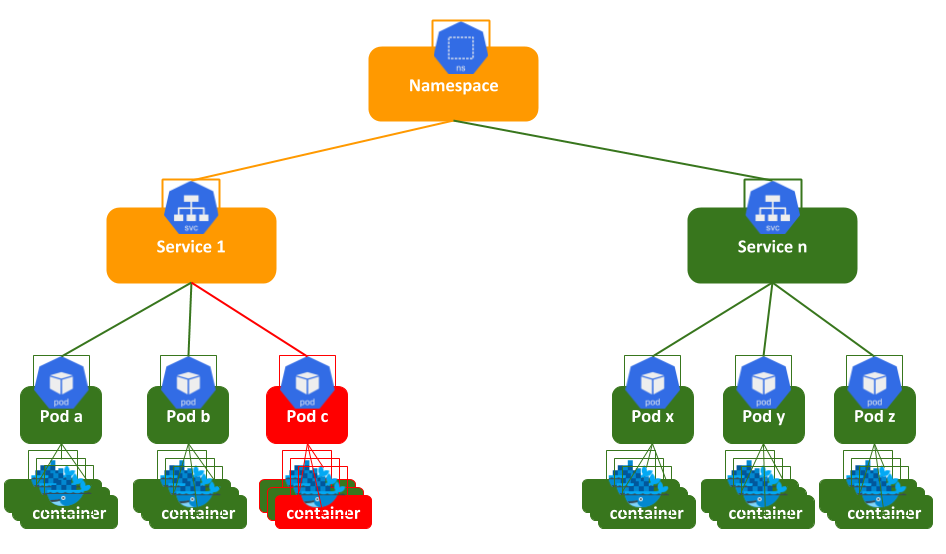

You don’t need cluster-level permission to create a namespace within your team namespace, and you also have the flexibility to apply different RBAC rules and network security groups at each level of the namespace hierarchy. With hierarchical namespaces, you can create a team namespace, and under it namespaces for specific workloads. For example, when a cluster is shared by multiple teams, each team can have a group of namespaces that belong to them. Hierarchical namespaces are an extension to the Kubernetes namespaces mechanism, which allows you to organize groups of namespaces that have a common owner. Related content: Read our guide to Kubernetes clusters The Hierarchical Namespace Controller (HNC)
#What is kubernetes namespace how to#
Here is how to create a namespace using kubectl: kube-node-lease-a default space for objects related to cluster scaling.Īdmins can create as many Kubernetes namespaces as necessary to isolate workloads or resources and limit access to specific users.kube-public-a default space for resources available to all users without authentication.kube-system-a default space for Kubernetes system objects, such as kube-dns and kube-proxy, and add-ons providing cluster-level features, such as web UI dashboards, ingresses, and cluster-level logging.default-a default space for objects that do not have a specified namespace.Here are the four default namespaces Kubernetes creates automatically: There are two types of Kubernetes namespaces: Kubernetes system namespaces and custom namespaces.

 Quick Tutorial: Working with Kubernetes Namespaces. When Should You Use Multiple Kubernetes Namespaces?. The Hierarchical Namespace Controller (HNC). Related content: Read our guide to Kubernetes architecture Kubernetes also allows admins to manually create custom namespaces. In a new cluster, Kubernetes automatically creates the following namespaces: default (for user workloads) and three namespaces for the Kubernetes control plane: kube-node-lease, kube-public, and kube-system. Using this technique can help you improve the security of your cluster. The role you define is applied to a namespace, and RoleBinding is applied to specific objects within this namespace. You can define a role object type and assign it using role binding. Apply access controls-namespaces let you define role-based access control (RBAC). You can also use container network interfaces (CNIs) to apply network policies that define how communication is achieved between pods in each namespace. For example, you can define resource policies to limit resource consumption. Apply policies to cluster segments-Kubernetes namespaces let you apply policies to different parts of a cluster. Here are two notable use cases for Kubernetes namespaces: It helps granularly organize, allocate, manage, and secure cluster resources. But for production, you might use another set of clusters (one cluster per app, or one cluster per X related apps), depending on the business and/or technical requirements.A Kubernetes namespace helps separate a cluster into logical units. So you might consider running all staging workloads on the same cluster, separated by namespaces. On separate clusters, it is much easier to manage. Additionally, if you use a single cluster-wide ingress controller, be aware that the ingress network traffic load on staging will impact the production - after all, same nginx pods will handle requests both directed to the staging and the production.Īlso, you might find it much harder to manage the authn/authz when you use a single cluster.
Quick Tutorial: Working with Kubernetes Namespaces. When Should You Use Multiple Kubernetes Namespaces?. The Hierarchical Namespace Controller (HNC). Related content: Read our guide to Kubernetes architecture Kubernetes also allows admins to manually create custom namespaces. In a new cluster, Kubernetes automatically creates the following namespaces: default (for user workloads) and three namespaces for the Kubernetes control plane: kube-node-lease, kube-public, and kube-system. Using this technique can help you improve the security of your cluster. The role you define is applied to a namespace, and RoleBinding is applied to specific objects within this namespace. You can define a role object type and assign it using role binding. Apply access controls-namespaces let you define role-based access control (RBAC). You can also use container network interfaces (CNIs) to apply network policies that define how communication is achieved between pods in each namespace. For example, you can define resource policies to limit resource consumption. Apply policies to cluster segments-Kubernetes namespaces let you apply policies to different parts of a cluster. Here are two notable use cases for Kubernetes namespaces: It helps granularly organize, allocate, manage, and secure cluster resources. But for production, you might use another set of clusters (one cluster per app, or one cluster per X related apps), depending on the business and/or technical requirements.A Kubernetes namespace helps separate a cluster into logical units. So you might consider running all staging workloads on the same cluster, separated by namespaces. On separate clusters, it is much easier to manage. Additionally, if you use a single cluster-wide ingress controller, be aware that the ingress network traffic load on staging will impact the production - after all, same nginx pods will handle requests both directed to the staging and the production.Īlso, you might find it much harder to manage the authn/authz when you use a single cluster. 
For example, you won't be able to test cluster upgrades on the staging environment first - you have a single cluster. Running staging and production on the same cluster can be ok, but you have to understand what that means, what are the risks and so on. So it is a fine way to manage RBAC and resource isolation.ĭepending on your requirements, you might want to move the production to a different cluster. The approach is ok, and namespaces do not cost anything (well, it is negligible).








 0 kommentar(er)
0 kommentar(er)
